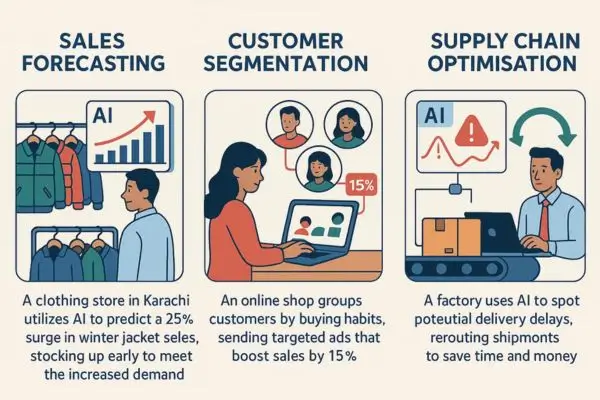What Is AI and Business Intelligence?
AI and Business Intelligence (BI) collects and analyses data to understand past performance. AI adds predictive power, automating insights and spotting patterns humans might miss. Together, they help businesses make smarter, faster decisions.
Topics
Table of Contents

Key Points
- AI Enhances Businesses: Artificial Intelligence (AI) supercharges Business Intelligence, providing us with faster and more insightful data that enables us to predict trends more accurately and make better decisions.
- Real-World Impact: From retail to healthcare, AI-driven BI helps businesses personalise offers, detect fraud, and optimise operations.
- Challenges Exist: Data privacy, skill gaps, and legacy systems can complicate AI-BI integration, but solutions are within reach.
- Future Trends: Expect more transparent AI, automated analytics, and storytelling tools to shape business analytics in 2025.
- Accessible to All: Both small and large businesses can leverage AI- and BI-based tools to stay competitive.
Why should we adopt AI in our Businesses?
In 2025, it is evident that companies are facing massive data growth in today’s world. The combination of AI and BI is necessary to handle this extensive data. AI provides real-time insights and competitive advantages across various industries, including retail, finance, and healthcare.
See also: AI Tools for Small Businesses: Top 12 Powerful Tools to Boost Your Businesshttps
How to Start?
Firstly, assess your current BI setup, select user-friendly tools like Microsoft Power BI, and train your team. You can start with a small pilot project to evaluate the benefits and advantages.
AI and Business Intelligence: Changing Business Analytics
Imagine running a business where decisions are informed by instant, razor-sharp insights from vast amounts of data. That’s the power of combining AI and business intelligence with AI and business analytics in 2025. Business Intelligence (BI) has long been the go-to for understanding past performance. Still, it’s getting a significant upgrade with Artificial Intelligence (AI). This duo is changing how companies operate, from small startups in Lahore to global giants in New York. Whether you’re predicting sales, personalising customer experiences, or streamlining operations, AI-powered BI is your ticket to staying ahead. Let’s dive into how this tech is reshaping the future, why it’s a big deal, and how you can jump on board!
What Is Business Intelligence (BI)?
Business Intelligence is like your company’s data detective. It gathers, stores, and analyses data to help you make sense of what’s happening. Traditional BI tools rely on data warehousing—think of it as a giant digital filing cabinet where all your sales, customer, and operational data lives. Dashboards and reports transform this data into easy-to-read visuals, such as charts showing last quarter’s profits.
For years, BI has helped businesses track performance and spot trends. But it has limits. It’s often slow, requires manual work, and struggles with messy data, such as social media posts or customer feedback. In 2025, with data growing faster than ever, these gaps are glaring. That’s where AI steps in to give BI a serious boost.
How AI Enhances Business Intelligence
AI is like a super-smart assistant for BI. It brings tools like Natural Language Processing (NLP), which lets you ask questions in plain English—like “What’s driving our sales drop?”—and get instant answers. Machine Learning (ML) digs deeper, analysing past data to predict future trends, such as which products will sell out next month. Automated insights are a game-changer; AI scans data 24/7, spotting patterns that humans might miss, such as a sudden spike in customer complaints.
This combination of AI and business intelligence enables faster and sharper decision-making. Instead of waiting for a report, you get real-time suggestions to act on. It’s like having a crystal ball for your business!

Example Use Cases
- Sales Forecasting: A clothing store in Karachi utilizes AI to predict a 25% surge in winter jacket sales, stocking up early to meet the increased demand.
- Customer Segmentation: An online shop groups customers by buying habits, sending targeted ads that boost sales by 15%.
- Supply Chain Optimisation: A factory uses AI to spot potential delivery delays, rerouting shipments to save time and money.
These examples demonstrate how AI and business analytics transform data into actionable insights, regardless of the industry.
Business Analytics vs. Business Intelligence: What’s the Difference?
Confused about BI versus business analytics? Here’s the scoop. BI looks backwards, summarising what has happened—much like a report showing last month’s revenue. Business analytics looks forward, using data to predict trends and suggest actions, such as why revenue dipped and how to address the issue.
AI bridges both. In BI, it speeds up data analysis and adds predictive power. In analytics, it offers real-time insights and recommendations. In 2025, the line between BI and analytics is blurring as AI integrates them into one powerful toolset, giving businesses a full view of past, present, and future.
Benefits of Integrating AI with BI
Merging AI with BI is like adding rocket fuel to your business. Here’s why:
- Real-Time Decisions: AI processes data instantly, letting you tweak marketing campaigns or adjust inventory on the fly.
- Less Bias: Algorithms cut through human assumptions, providing clear and objective insights.
- Scales Easily: AI handles huge data volumes, growing with your business without extra hassle.
- Customer Insights: AI predicts what customers want, helping you craft personalised experiences that boost loyalty.
These perks make business intelligence and AI a must-have for staying competitive in 2025.
Industries Using AI-Powered BI and Analytics
AI-powered BI is transforming industries worldwide:
5. Retail: Stores like Amazon use AI to suggest products, increasing sales with personalised offers.
6. Healthcare: Hospitals predict disease outbreaks or patient risks, improving care and saving lives.
7. Finance: Banks detect fraud in real-time, spotting suspicious transactions before they cause harm.
8. Manufacturing: Factories optimise production, cutting waste and boosting efficiency with AI insights.
From Lahore to London, these industries show how AI and business analytics deliver results tailored to specific needs.
IndustryAI-BI ApplicationImpact
Retail Personalised offers boost sales by 10-20%
Healthcare Predictive diagnostics improves patient outcomes
Finance Fraud detection Saves millions in losses
Manufacturing Process optimisation cuts waste by up to 30%
Top AI and BI Tools and Platforms
Ready to dive in? Here are the top tools for 2025:
- Microsoft Power BI + Azure AI: Offers user-friendly dashboards with predictive analytics. Great for small businesses. powerbi.microsoft.com
- Tableau with Einstein Analytics: Excels at visual storytelling, powered by Salesforce’s AI. Ideal for data-driven teams
- Qlik: Flexible for complex data, with strong AI integration.
- Sisense: Perfect for embedding analytics into apps.
- IBM Watson Analytics: Deep learning for advanced insights, suited for large firms. ibm.com/watson
Pick a tool based on your budget and data needs. Small businesses in Pakistan might start with Power BI’s affordable plans, while global corporations might lean toward IBM Watson.
Risks: AI and Business Intelligence Integration
It’s not all smooth sailing. Here are the key hurdles in 2025:
- Data Privacy and Security: AI needs lots of data, but leaks can lead to fines or lost trust. Robust security is a must.
- Skill Gaps: Finding workers skilled in both AI and BI is tough. Training or hiring experts is essential.
- Legacy Systems: Old BI systems often don’t play nice with new AI tech, requiring costly upgrades.
- Ethical Concerns: AI must be transparent to avoid bias and build trust. Explainable AI (XAI) is gaining traction as a means to address this.
These challenges are real but manageable with planning and investment. For example, businesses in Karachi can tap into local tech training programs to bridge skill gaps.
See Also: 2025’s Hottest Technology Innovations Changing Everything
Future Trends in AI-Driven Business Analytics
The future of AI and business intelligence is an exciting prospect. Here’s what’s coming in 2025:
- Explainable AI (XAI): Makes AI decisions clear, so you know why it suggests specific actions.
- Augmented Analytics: Automates data prep, letting non-experts analyse data easily.
- AI-Powered Storytelling: Turns numbers into engaging stories, making insights accessible to all.
- Predictive and Prescriptive Analytics: Predicts trends and suggests next steps, like which products to promote.
These trends, noted in sources like MIT Sloan, will make BI more user-friendly and impactful.
Getting Started with AI in Your BI Strategy
Ready to jump in? Here’s how:
- Assess Your Setup: Check your current BI tools. Where do they fall short?
- Pick the Right Tools: Start with user-friendly options like Power BI or Tableau.
- Train Your Team: Use online courses or hire AI experts to build skills.
- Start Small: Try a pilot project, such as predicting sales for a single product line.
- Scale Up: Expand as you see results, integrating AI across departments.
Local businesses in Pakistan can leverage affordable cloud-based tools and tap into global training resources to get started.
Conclusion
The fusion of AI and business intelligence, combined with AI and business analytics, is reshaping how businesses operate in 2025. From real-time decisions to personalised customer experiences, this tech duo is a game-changer. Yes, challenges like data privacy and skill gaps exist, but with the right tools and strategy, any business can thrive. Whether you’re a startup in Lahore or a corporation in Dubai, now’s the time to embrace AI-powered BI. Start small, experiment, and watch your business soar. Got a question? Drop it below and let’s chat!
FAQs
- What’s the difference between AI and business intelligence?
AI predicts and automates; BI reports on past data. Together, they cover past, present, and future.
2. Can AI replace traditional BI tools?
Not fully—AI enhances BI but needs its structure for historical analysis.
3. Is AI in BI only for large companies?
No, tools like Power BI make it affordable for small businesses too.
4. How secure is AI in business analytics?
An Important Suggestion by HS Tech: It’s safe if you use robust data protection measures, such as encryption and regular compliance checks.